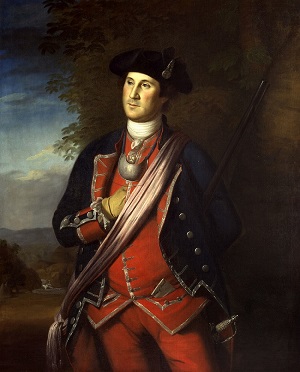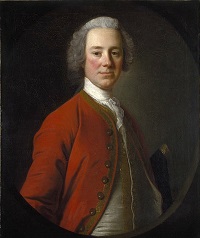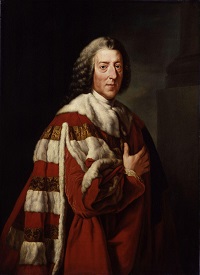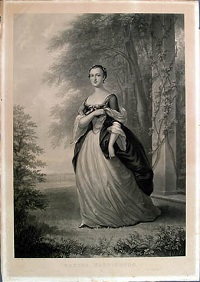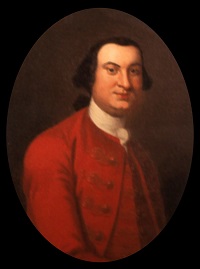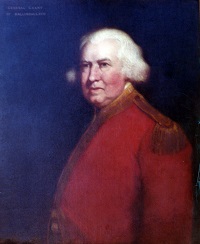George Washington: The Soldier Through the French and Indian War
Page 3
The immediate effect of the defeat of Braddock's forces was disastrous. Colonel Thomas Dunbar, who commanded the rear of Braddock's Army, which had not participated in the battle, refused, after receiving the fugitives, to advance or even to stand his ground, but retreated first to Fort Cumberland and then to Philadelphia, leaving the entire border at the mercy of the raids of the French and Indians.
This emergency brought forth the convening of the House of Burgesses of the colony of Virginia by Governor Dinwiddie, which authorized the raising of a regiment of 1,000 men and 40,000 pounds for provisions. The governor gave George Washington a commission as colonel and commander in chief of all of the forces raised in Virginia for the protection of the frontier. Washington wanted to take the offensive and launch attacks on strategic positions held by the French, but was overruled by his superiors. Instead, the British remained on the defenive, maintaining numerous small fortified posts, most of which were not garrisoned with sufficient troops to defend themselves and the surrounding territories from raids by the local native tribes, let alone an organized and well-equipped army, should the French attack.
George Washington was gravely disturbed over the situation, and he wrote many letters in his efforts to induce the authorities to provide him with adequate means to protect the border settlers. In a letter to Governor Dimwiddie dated April 22, 1756, Washington describes his anguish concerning his inability to take action to defend his compatriots:
"I see their situation, know their danger, and participate in their sufferings, without having it in my powere to give them further relief, than uncertain promises. In short, I see inevitable destruction in so clear a light, that, unless vigorous measures are taken by the Assembly, and speedy assistance sent from below, the poor inhabitants that are now in forts, must unavoidably fall while the remainder of the country are flying before the barbarous foe . . . The supplicating tears of women, and moving petitions from the men, melt me into such deadly sorrow, that I solemnly declare, if I know my own mind, I could offer myself a willing sacrifice to the butchering enemy, provided that would contribute to the people's ease."
The Virginia authorities made some efforts to remedy these troubles, but there was a lack of intercolonial cooperation, and under the commanding generalship of Lord Loudoun, Virginia was not only left to its own defense but required to send troops to South Carolina. Recruiting was slow. Men were not willing to leave their homes and families, and George Washington had a most arduous service in trying to defend 350 miles of frontier with less than a thousand men. This condition continued through 1756-57. For two years there was nothing but a series of failures under Lord Loudoun until he was recalled.
The tide of the war turned in American under the able leadership of William Pitt, leader of the House of Commons from 1757 to 1761. Pitt was singularly devoted to defeating the French in North America. With his support, the colonies were amply supplied with troops and provisions. In 1758, Washington led a regiment of Virginia troops in another expedition to capture Fort Duquesne, under the command of General John Forbes.
Prior to embarking on the Forbes campaign, Washington met and wooed a young widow named Martha Custis. Before his departure on the road to Fort Duquesne, the two were betrothed. In 1758, Washington was elected to the Virginia House of Burgesses as representative for Frederick County, an office he held until 1764, though his military duties occupied much of his time and attention during this period.
A notable contrast to General Braddock's disregard of George Washington's advice was the respect tendered his military opinions by General Forbes, who asked the young officer to make for him a plan of march, a tactical scheme for the conduct of an expeditionary force of 4,000 men. It was also astonishing to find the young officer fully prepared to offer the right solution to the problem with tactics so flexible as to change quickly a line of march into a battle line in the event of an attack. The value of this plan was so apparent that it was adopted and followed.
General Forbes's expedition advanced with painful slowness. Colonel Henry Bouquet, who had advocated the new route, was energetic, but the making of the new road through the wilderness was very difficult, and the approach to Fort Duquesne was delayed until in danger of being halted by the winter weather.
After the defeat of General James Abercromby in his attack on Fort Ticonderoga, July 8, 1758, Fort Frontenac had been left with only a little over a hundred men to garrison it and was therefore easily captured in August by Colonel John Bradstreet, who crossed Lake Ontario with a force of 2,500 colonial troops.
The loss of this valuable French post cut the French line of communications, and by the time the Forbes expedition appeared the weakened forces at Fort Duquesne abandoned their isolated position. They had routed a rash advance force under Major James Grant, but abandoned by their Indian allies, they could not withstand the main body and after burning their fort, retreated up the Allegheny. It saved the situation, for General Forbes was then fatally ill. The fort was made defensible and renamed by him Fort Pitt (afterwards Pittsburgh). Two hundred of Washington's Virginians were left as a garrison, and the expedition returned to Virginia. The downfall of Fort Duquesne ended the border troubles, just as George Washington had predicted it would, as it had been the base of all the Indian raiding activities. The restoration of order on the border ended the war for Virginia; the French being driven away, the end of 1758 was the end of George Washington's military service in the French and Indian War.
Adapted from "George Washington: Soldier through the French and Indian War" Prepared for the U.S. George Washington Bicentennial Commission, Submitted by Mrs. Franklin B. Wildman, The Picket Post, The Valley Forge Historical Society. January 1966
